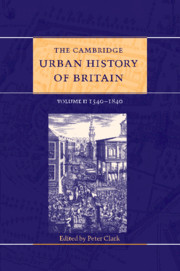Book contents
- Frontmatter
- 1 Introduction
- Part I Area surveys 1540–1840
- Part II Urban themes and types 1540–1700
- Part III Urban themes and types 1700–1840
- 14 Urban growth and economic change: from the late seventeenth century to 1841
- 15 Population and society 1700–1840
- 16 Politics and government 1700–1840
- 17 Culture and leisure 1700–1840
- 18 The transformation of urban space 1700–1840
- 19 London 1700–1840
- 20 Regional and county centres 1700–1840
- 21 Ports 1700–1840
- 22 Small towns 1700–1840
- 23 Health and leisure resorts 1700–1840
- 24 Industrialising towns 1700–1840
- 25 Conclusion
- Select Bibliography
- Index
- References
18 - The transformation of urban space 1700–1840
from Part III - Urban themes and types 1700–1840
Published online by Cambridge University Press: 28 March 2008
- Frontmatter
- 1 Introduction
- Part I Area surveys 1540–1840
- Part II Urban themes and types 1540–1700
- Part III Urban themes and types 1700–1840
- 14 Urban growth and economic change: from the late seventeenth century to 1841
- 15 Population and society 1700–1840
- 16 Politics and government 1700–1840
- 17 Culture and leisure 1700–1840
- 18 The transformation of urban space 1700–1840
- 19 London 1700–1840
- 20 Regional and county centres 1700–1840
- 21 Ports 1700–1840
- 22 Small towns 1700–1840
- 23 Health and leisure resorts 1700–1840
- 24 Industrialising towns 1700–1840
- 25 Conclusion
- Select Bibliography
- Index
- References
Summary
INTRODUCTION
the fabric of the urban environment experienced accelerating change during the course of the eighteenth century, and the pace of change in some towns, although by no means all, underwent a dramatic gearshift from the 1780s onwards. These changes were driven by rapid population growth and migration, and by technological innovation, leading to the mechanisation of transport and of many manufacturing processes. Central government and municipal authorities contributed very little to this metamorphosis, unlike the experience of many European cities. The traditional pattern of urban social geography, in which the well-to-do lived in the centres of towns and the poor in the suburbs, was shattered in many towns in the late eighteenth and early nineteenth centuries and replaced by suburban residential segregation based upon socio-economic status and the separation of home and work, in its turn dependent upon ease of transport. Everywhere it is a subtle, complex process of transformation. In some towns, such as Glasgow, it takes place within a generation. In other towns, unaffected by the first stages of industrialisation, it was the end of the nineteenth century before these processes had fully worked themselves out.
Much of this growth and change had to be accommodated within ancient boundaries and administrative structures, creating problems of health, sanitation and housing upon an unprecedented scale. These problems were widely recognised by the 1830s, but it is the 1840s before central government begins to take the first tentative steps towards putting things right.
- Type
- Chapter
- Information
- The Cambridge Urban History of Britain , pp. 615 - 640Publisher: Cambridge University PressPrint publication year: 2000
References
- 2
- Cited by



